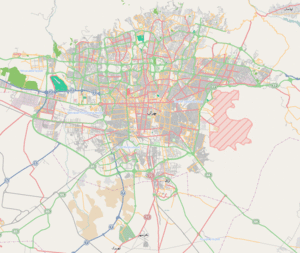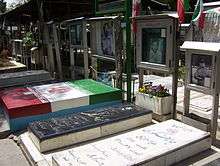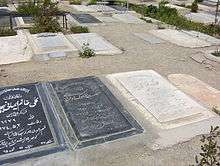Behesht-e Zahra
 | |
 Shown within Tehran | |
| Details | |
|---|---|
| Established | 1970 |
| Location | Tehran |
| Country | Iran |
| Coordinates | 35°32′10″N 51°22′12″E / 35.536°N 51.370°E |
| Type | Public |
| Size | 534 hectares (1,320 acres) |
| Number of graves | 1,300,000 |
| Website |
www |
| Find a Grave |
Behesht-e Zahra بهشت زهرا |
Behesht-e Zahra (Persian: بهشت زهرا,The Paradise of Zahara), is the largest cemetery in Iran. Located in the southern part of metropolitan Tehran,[1] it is connected to the city by metro line No. 1. The cemetery has been one of the inspirations for the popular webcomic, Zahra's Paradise.
History
In the early 1950s, all the cemeteries in Tehran were supposed to be replaced by several large new ones outside the then precincts of the capital. Behesht-e Zahra was built in late 1960s on the southern side of Teheran towards the direction of the city of Qom and opened in 1970. The first person buried in Behesht-e Zahra was Mohammad-Taghi Khial.
Many of the deceased soldiers of the Iran–Iraq War were buried in the martyr's section of the graveyard.[2][3]
Notable burials
- Royalties
- Hamdamosaltaneh Pahlavi (1903–1978) – daughter of Reza Shah
- Ezzosaltaneh Qajar (1891–1984) – daughter of Nasser al-Din Shah Qajar
- Sadigheh Pahlavi (1917–1990) – daughter of Reza Shah
- Hamid Reza Pahlavi (1932–1992) – youngest son of Reza Shah
- Esmat Dowlatshahi (1904–1995) – Reza Shah's wife
- Politicians (Pahlavi Era)
- Hossein Navab (1897–1972) – minister of foreign affairs (1952)
- Mohammad Sa'ed (1883–1973) – prime minister of Iran (1944) and (1948–50)
- Amir-Abbas Hoveyda (1919–1979) – prime minister of Iran (1965–77) and leader of Rastakhiz party
- Mahmoud Jafarian (1927–1979) – director-general of National Iranian Radio & Television (NIRT)
- Abbas Aram (1906–1985) – minister of foreign affairs (1959–1966)
- Jahanshah Saleh (1904–1996) – senator
- Mehrangiz Manouchehrian (1906–2000) – lawyer and senator
- Sabar Farman-Farmaian (1912–2006) – minister of health (1953)
- Military personnel
- Nematollah Nassiri (1910–1979) – Imperial Iranian Army (IIA) general and head of SAVAK (1965–78)
- Jafarqoli Sadri (1911–1979) – head of National Police
- Mehdi Rahimi (1921–1979) – IIA general
- Reza Naji (1922–1979) – IIA general
- Manouchehr Khosrowdad (1927–1979) – IIA general
- Nader Jahanbani (1928–1979) – Imperial Iranian Air Force (IIAF) general
- Amir Hossein Rabii (1931–1979) – commander in chief of IIAF (1977–79)
- Houshang Vahid Dastjerdi (1925–1981) – head of National Police
- Valiollah Fallahi (1931–1981) – chief of staff of Islamic Republic of Iran Army (IRIA)
- Javad Fakoori (1938–1981) – chief of staff of Islamic Republic of Iran Air Force (IRIAF)
- Ahmad Keshvari (1953–1981) – IRIA pilot
- Hossein Fardoust (1917–1987) – IIA general and deputy head of SAVAK
- Bahram Hooshyar (1938–1991) – IRIAF pilot
- Mansour Sattari (1948–1995) – chief of staff of IRIAF
- Ali Sayad Shirazi (1944–1999) – chief of staff of IRIA
- Qasem-Ali Zahirnejad (1924–1999) – chief of staff of IRIA
- Jalil Zandi (1951–2001) – IRIAF ace fighter pilot
- Mahoammad-Hadi Shadmehr (1920–2008) – chief of staff of IRIA
- Political dissidents
- Saeed Mohsen (1939–1972) – Marxist activist and a founder of People's Mujahedin of Iran (PMOI)
- Mohammad Hanifnejad (1940–1972) – Marxist activist and a founder of PMOI
- Ali-Asghar Badizadegan (1940–1972) – Marxist activist and a founder of PMOI
- Khosrow Golsorkhi (1944–1974) – Marxist activist and member of Tudeh Party
- Keramatollah Daneshian (1944–1974) – Marxist activist and poet
- Bijan Jazani (1938–1975) – Marxist activist and a founder of Organization of Iranian People's Fedai Guerrillas (OIPFG)
- Hamid Ashraf (1946–1976) – Marxist activist and a founder of OIPFG
- Ali Andarzgoo (1937–1978) – Islamist activist
- Kamran Nejatollahi (1953–1978) – scholar
- Ali Shayegan (1901–1981) – member of the National Front
- Mozzafar Baghai (1911–1987) – member of the National Front
- Ali-Akbar Sa'idi Sirjani (1931–1994) – journalist
- Ahmad Zirakzadeh (1907–1993) – member of the National Front
- Homa Darabi (1940–1994) – pediatrician
- Ebrahim Zalzadeh (1948–1997) – author
- Dariush Forouhar (1928–1998) – founder of Nation Party of Iran
- Parvaneh Forouhar (1938–1998) – politician
- Majid Sharif (1950–1998) – journalist
- Hossein Makki (1911–1999) – member of the National Front
- Noureddin Kianouri (1915–1999) – Marxist activist and general secretary of Tudeh Party
- Parviz Varjavand (1934–2007) – scholar and member of the National Front
- Zahra Bani Yaghoub (1980–2007) – physician
- Maryam Firouz (1914–2008) – communist member of Tudeh party
- Seyed Ali Mousavi (1966–2009) – protester
- Neda Agha-Soltan (1983–2009) – protester
- Ramin Pourandarjani (1983–2009) – physician
- Mohsen Rouholamini (1984–2009) – protester
- Mohammad Mokhtari (1989–2009) – protester
- Sohrab Aarabi (1990–2009) – protester
- Siamak Pourzand (1931–2011) – journalist
- Hoda Saber (1959–2011) – journalist
- Mohammad Mokhtari (1989–2011) – protester
- Farideh Mashini (1960–2012) – feminist
- Politicians (Islamic Republic)
- Mahmoud Taleghani (1911–1979) – cleric and a founder of Freedom Movement of Iran
- Mohammad Hossein Fahmideh (1967–1980) – war hero
- Mostafa Chamran (1932–1981) – minister of defence[4]
- Mohammad Beheshti (1928–1981) – chief justice of Iran (1979–81) and head of Islamic Republic Party (IRP)
- Mousa Namjoo (1938–1981) – minister of defence
- Hassan Ayat (1938–1981) – member of IRP
- Mohammad-Javad Bahonar (1933–1981) – prime minister of Iran (1981)
- Mohammad-Ali Rajai (1933–1981) – prime minister (1980–81) and president of Iran (1981)
- Hassan Abbaspour (1944–1981) – minister of energy
- Mahmoud Qandi (1944–1981) – minister of communication
- Mohammad Jahanara (1954–1981) – member of Islamic Revolution Guard Corps (IRGC)
- Mohammad Boroujerdi (1955–1983) – member of IRGC
- Mohammad Ebrahim Hemmat (1955–1984) – member of IRGC
- Mahmoud Kaveh (1961–1986) – member of IRGC
- Ruhollah Khomeini (1902–1989) – cleric and supreme leader of the Islamic Republic of Iran (1979–1989)
- Mohammad Javad Tondguyan (1938–1991) – minister of petroleum
- Morteza Avini (1947–1993) – war photographer
- Ahmad Khomeini (1945–1995) – cleric and politician
- Asadollah Lajevardi (1935–1998) – warden of Evin Prison
- Rahman Dadman (1956–2001) – minister of roads and transportation
- Mohsen Nourbakhsh (1948–2003) – governor of the Central Bank
- Jamal Karimi-Rad (1956–2006) – minister of justice
- Ahmad Kazemi (1958–2006) – member of IRGC
- Mohammad-Reza Tavassoli (1931–2008) – cleric
- Ahmad Bourghani (1959–2008) – Majles MP
- Khadijeh Saqafi (1913–2009) – Khomeini's wife
- Hassan Habibi (1937–2013) – vice president
- Habibollah Asgaroladi (1932–2013) – minister of commerce
- Mostafa Davoudi (1939–2015) – chairman of National Sports Organisation
- Sadeq Tabatabaei (1943–2015) – deputy prime minister
- Marzieh Hadidchi (1939–2016) – Majles MP
- Scholars & Journalists
- Abdolreza Houshang Mahdavi (1930-2016) - diplomat, scholar, writer, translator, member of the Academy of Persian Language and Literature
- Mojtaba Minovi (1903–1976) – scholar
- Mohsen Hashtroodi (1908–1976) – scholar
- Issa Seddiq (1894–1978) – scholar and founder of the University of Tehran
- Azar Andami (1926–1984) – physician
- Abbas Nalbandian (1949–1989) – playwright
- Parviz Natel-Khanlari (1914–1990) – linguist and scholar
- Mehrdad Avesta (1930–1991) – poet
- Bahram Farahvashi (1925–1992) – linguist
- Ahmad Fardid (1909–1994) – philosopher
- Mehrdad Bahar (1930–1994) – linguist
- Mohammad Javad Mashkour (1918–1995) – scholar
- Abbas Zaryab (1919–1995) – scholar
- Mohammad Taghi Daneshpajouh (1911–1996) – scholar
- Karim Fakoor (1926–1996) – poet
- Ahmad Tafazzoli (1937–1997) – scholar
- Ahmad Aram (1904–1998) – scholar
- Hamid Mosadegh (1940–1998) – poet
- Morteza Ravandi (1913–1999) – scholar
- Jafar Shahri (1914–1999) – ethnographer
- Abdolhossein Zarrinkoob (1923–1999) – scholar
- Mahmoud Mosaheb (1912–2000) – scholar
- Abbas Sahab (1921–2000) – scholar
- Parviz Shapour (1924–2000) – writer and satirist
- Fereydun Moshiri (1926–2000) – poet
- Parviz Dariush (1922–2001) – poet
- Yahya Zoka (1923–2001) – scholar
- Amir-Hossein Aryanpour (1925–2001) – lexicographer
- Gholamhossein Ahani (1927–2001) – scholar
- Ahmad Birashk (1907–2002) – scholar
- Mostafa Rahimi (1926–2002) – scholar
- Reza Beykzadeh (1946–2002) – journalist
- Farrokh Tamimi (1933–2002) – poet
- Iraj Bastami (1957–2003) – poet
- Abdolhossein Navaei (1924–2004) – scholar
- Kioumars Saberi Foumani (1941–2004) – satirist
- Shahrokh Meskoob (1924–2005) – scholar
- Esmail Navvab Safa (1925–2005) – poet
- Karim Emami (1930–2005) – translator
- Nowzar Parang (1937–2006) – poet
- Iraj Zand (1950–2006) – sculptor
- Houshang A'lam (1928–2007) – scholar
- Mahdi Ghalibafian (1935–2007) – scholar
- Bagher Ayatollahzadeh Shirazi (1936–2007) – scholar
- Akbar Radi (1939–2007) – playwright
- Fereydun Adamiyat (1920–2008) – historian
- Nader Ebrahimi (1936–2008) – writer
- Massoud Azarnoush (1945–2008) – archeologist
- Mehran Ghassemi (1977–2008) – journalist
- Roza Montazemi (1921–2009) – author
- Abolghassem Mas'udi (1930–2009) – journalist
- Bijan Taraghi (1930–2009) – poet
- Esmail Fasih (1935–2009) – writer
- Enayatollah Reza (1920–2010) – scholar
- Seifollah Kambakhsh-Fard (1929–2010) – archeologist
- Rahim Rezazadeh Malek (1940–2010) – historian
- Shokouh Mirfattah (1946–2010) – scholar
- Iraj Afshar (1925–2011) – bibliographer and historian
- Manouchehr Vesal (1913–2012) – scholar
- Simin Daneshvar (1921–2012) – scholar and novelist
- Ehsan Naraghi (1926–2012) – scholar
- Parviz Rajabi (1939–2012) – scholar
- Baqer Aqeli (1929–2013) – scholar
- Parvaneh Vosouq (1936–2013) – physician and entpreneur
- Mohammad-Ebrahim Bastani Parizi (1924–2014) – historian
- Simin Behbahani (1927–2014) – poet
- Naser Katouzian (1931–2014) – scholar
- Mahmoud Toloui (1930–2015) – historian
- Mohammad-Ali Sepanlou (1940–2015) – poet
- Nasser Pourpirar (1940–2015) – writer
- Shahriar Adle (1944–2015) – archeologist
- Morteza Sohrabi (1946–2015) – scholar
- Hamid Golpira (1960–2015) – journalist
- Davood Parsa-Pajouh (1941–2015) – scholar
- Artists
- Javad Badizadeh (1902–1979) – musician
- Esmail Adib Khansari (1901–1982) – musician
- Hossein Gol-e-Golab (1895–1984) – poet and musician
- Mahmoud Mahmoudi Khansari (1933–1987) – singer
- Amanollah Tajik (1937–1987) – singer
- Javad Maroufi (1912–1993) – musician
- Abolhassan Sadighi (1894–1995) – painter and sculptor
- Heshmat Sanjari (1918–1995) – composer and conductor
- Hossein Sarshar (1934–1995) – singer and actor
- Giti Pashaei (1940–1995) – singer
- Rassam Arabzadeh (1914–1995) – carpet designer
- Changiz Shahvagh (1933–1996) – painter and sculptor
- Jalil Ziapour (1920–1999) – painter
- Rouhollah Emami (1940–1999) – film editor
- Jahangir Malek (1933–2002) – musician
- Asadollah Malek (1941–2002) – musician
- Morteza Varzi (1922–2004) – musician
- Hadi Ameri (1913–2005) – composer and conductor
- Jafar Petgar (1920–2005) – painter
- Fereydoon Nasseri (1930–2005) – conductor
- Ali Akbar San'ati (1916–2006) – painter and sculptor
- Ali Tajvidi (1919–2006) – musician
- Babak Bayat (1946–2006) – musician
- Fakhereh Saba (1920–2007) – opera singer
- Hamid Qanbari (1924–2007) – singer
- Elaheh (1934–2007) – singer
- Parviz Yahaghi (1936–2007) – composer
- Ghorban Soleimani (1920–2008) – musician and vocalist
- Abbas Katouzian (1923–2008) – painter and artist
- Khatereh Parvaneh (1929–2008) – singer
- Nikol Faridani (1935–2008) – photographer
- Shusha Guppy (1935–2008) – writer, editor and singer
- Jazeh Tabatabai (1938–2008) – painter
- Nami Petgar (1945–2008) – painter
- Abbas Sakhaei (1953–2008) – actor and photographer
- Faramarz Payvar (1933–2009) – musician
- Hassan Shojaei (1941–2009) – singer
- Mehdi Sahabi (1944–2009) – painter and sculptor
- Parviz Meshkatian (1955–2009) – musician
- Mohammad Nouri (1929–2010) – singer
- Bahman Jalali (1944–2010) – photographer
- Andre Arzoumanian (1954–2010) – musician
- Homayoun Khorram (1930–2013) – musician
- Jalil Shahnaz (1921–2013) – musician
- Morteza Pashaei (1984–2014) – singer
- Mansour Nariman (1935–2015) – musician
- Nima Petgar (1947–2015) – painter
- Actors/Actresses
- Parviz Fanizadeh (1937–1979) – actor
- Habibollah Bolour (1913–1982) – actor and wrestler
- Mohammad Taghi Kahnamouei (1919–1983) – actor
- Saber Atashin (1926–1987) – actor
- Ezzatollah Moghbeli (1933–1988) – actor
- Ezzatollah Vosough (1914–1991) – actor
- Houshang Beheshti (1923–1991) – actor
- Farhang Mehrparvar (1946–1994) – actor
- Roghieh Chehreh Azad (1907–1995) – actress
- Iran Daftari (1907–1996) – actress
- Gholam-Hossein Naghshineh (1908–1996) – actor
- Valiollah Khakdan (1923–1996) – art director
- Jalal Moghaddam (1929–1996) – film director
- Manouchehr Hamedi (1939–1996) – actor
- Ali Hatami (1944–1996) – film director
- Rouhangiz Saminejad (1916–1997) – actress
- Jahangir Forouhar (1916–1997) – actor
- Ali Tabesh (1925–1997) – actor
- Ali Asghar Garmsiri (1911–2000) – actor
- Mohammad Ali Fardin (1930–2000) – actor and wrestler
- Nematollah Gorji (1926–2000) – actor
- Jamileh Sheykhi (1930–2001) – actress
- Mansour Valamaqam (1936–2001) – actor
- Kanaan Kiani (1932–2002) – actor
- Reza Jian (1949–2003) – actor
- Mehdi Fat'hi (1939–2004) – actor
- Manouchehr Nowzari (1925–2005) – actor
- Fereydun Goleh (1942–2005) – film director
- Ahmad Ghadakchian (1920–2006) – actor
- Abdolali Homayun (1920–2006) – actor
- Soroush Khalili (1937–2006) – actor
- Vakhtang Nersi Korkia (1938–2006) – actor
- Poopak Goldarreh (1971–2006) – actress
- Garsha Raoufi (1933–2007) – actor
- Esmail Davarfar (1932–2008) – actor
- Khosrow Shakibai (1944–2008) – actor
- Ahmad Aqaloo (1949–2008) – actor
- Parvin Soleimani (1922–2009) – actress
- Farrokh-Leqa Houshmand (1929–2009) – actress
- Abbas Shabaviz (1929–2009) – actor
- Ali Miri (1936–2009) – actor
- Seifollah Daad (1955–2009) – film director
- Peyman Abadi (1972–2009) – stuntman
- Niku Kheradmand (1932–2009) – actress
- Hamideh Kheirabadi (1924–2010) – actress
- Mahin Shahabi (1936–2010) – actress
- Mohammad Varshowchi (1925–2011) – actor
- Mehri Vedadian (1936–2011) – actress
- Hamid Samandarian (1931–2012) – theater director
- Abdollah Boutimar (1933–2012) – actor
- Touti Salimi (1954–2012) – actress
- Saadi Afshar (1934–2013) – actor
- Asal Badiee (1977–2013) – actress
- Hassan Raziani (1931–2014) – actor
- Nasser Gitijah (1935–2014) – actor
- Anoushirvan Arjmand (1941–2014) – actor
- Baqer Sahraroudi (1942–2014) – actor
- Morteza Ahmadi (1924–2014) – actor
- Ali Tabatabaei (1983–2015) – actor
- Homa Rousta (1944–2015) – actress
- Forouzan (1937–2016) – actress
- Davoud Rashidi (1933–2016) – actor
- Athletes
- Hossein Sadaghiani (1903–1982) – football player and coach
- Mahmoud Namjoo (1918–1990) – weight-lifter and olympian
- Parviz Dehdari (1935–1992) – football player and coach
- Mehrab Shahrokhi (1944–1993) – football player
- Jafar Salmasi (1918–2000) – weight-lifter and first Iranian olympic medalist
- Abbas Ekrami (1915–2002) – football manager
- Hossein Fekri (1924–2003) – football player
- Shamseddin Seyed-Abbasi (1943–2004) – wrestler
- Naser Karfarsa (1923–2005) – football player
- Hamid Shirzadegan (1941–2007) – football player
- Aidin Nikkhah Bahrami (1982–2007) – basketball player
- Aboutaleb Talebi (1945–2008) – wrestler
- Fariborz Moradi (1964–2008) – football player
- Abbas Qarib (1916–2009) – football player
- Masoud Boroumand (1928–2011) – football player
- Nasser Hejazi (1949–2011) – football player
- Leila Esfandyari (1970–2011) – mountain climber
- Abdollah Mojtabavi (1925–2012) – wrestler
- Hossein Madani (1971–2014) – volleyball player
- Gholam Hossein Mazloumi (1950–2014) – football player
- Hossein Maadani (1971–2014) – volleyball player
- Aref Gholizadeh (1938–2015) – football player
- Reza Ahadi (1962–2016) – football player
- Homayoun Behzadi (1942–2016) – football player
- Others
- Mahafarid Amir Khosravi (1969–2014) – businessman
- Reyhaneh Jabbari (1988–2014) – convict
In addition to tombs of the royals, politicians, and other significant people, in the graveyard there are symbolic tombs for the perpetrators of the 1983 Hezbollah attacks on the U.S. Marine and French peacekeepers' barracks in Beirut and for the assassin of Anwar Sadat, Khalid Islambouli.[2] Similarly, a symbolic tomb was erected in the cemetery for Hezbollah member Imad Mughniyah, who was killed on 12 February 2008 in Damascus, Syria.[5]
Images
-
Tomb of Ruhollah Khomeini
-

Tombs of Mostafa Chamran and Javad Fakoori
-

Tomb of Esmat Dowlatshahi
-

Tomb of Mohammad Sa'ed
-

Private tombs
-
-

Hafte Tir bombing victims' memorial outside view
-

Hafte Tir bombing victims' memorial
-

Iran-Iraq war victims' tombs
-

Prepared graves
-
.jpg)
Shohada street
See also
References
| Wikimedia Commons has media related to Beheshte Zahra Cemetery. |
- ↑ Sahimi, Mohammad (3 February 2010). "The Ten Days That Changed Iran". PBS. Los Angeles. Retrieved 30 July 2013.
- 1 2 Alfoneh, Ali (Winter 2007). "Iran's Suicide Brigades". Middle East Quarterly. XIV (7): 37–44. Retrieved 8 August 2013.
- ↑ Thomas Goltz (8 April 2015). Azerbaijan Diary: A Rogue Reporter's Adventures in an Oil-rich, War-torn, Post-Soviet Republic. Routledge. pp. 442–. ISBN 978-1-317-47624-5.
- ↑ Scott Peterson (21 September 2010). Let the Swords Encircle Me: Iran – A Journey Behind the Headlines. Simon & Schuster. p. 701. ISBN 978-1-4165-9739-1. Retrieved 5 August 2013.
- ↑ Chalhoub, Elie (14 February 2012). "Imad Mughniyeh in Iran: The Stuff of Legends". Al Akhbar. Retrieved 4 August 2013.